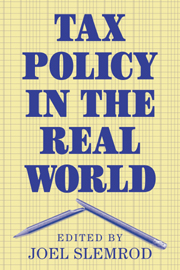Book contents
- Frontmatter
- Contents
- List of contributors
- 1 The real world of tax policy
- 2 Federal tax reform
- 3 Federalism and subfederal taxes
- Threading the fiscal labyrinth: some issues in fiscal decentralization
- A policymaker's guide to fiscal decentralization
- Fiscal decentralization and economic development
- Federalism and reductions in the federal budget
- Issues raised by the new federalism
- Fiscal equalization and school finance
- The case for equalizing aid
- Fiscal equalization: an empty box?
- How would you know a good economic development policy if you tripped over one? Hint: don't just count jobs
- Jobs, productivity, and local economic development: what implications does economic research have for the role of government?
- 4 Principles, politics, and the professors
- Index
Fiscal decentralization and economic development
Published online by Cambridge University Press: 01 June 2010
- Frontmatter
- Contents
- List of contributors
- 1 The real world of tax policy
- 2 Federal tax reform
- 3 Federalism and subfederal taxes
- Threading the fiscal labyrinth: some issues in fiscal decentralization
- A policymaker's guide to fiscal decentralization
- Fiscal decentralization and economic development
- Federalism and reductions in the federal budget
- Issues raised by the new federalism
- Fiscal equalization and school finance
- The case for equalizing aid
- Fiscal equalization: an empty box?
- How would you know a good economic development policy if you tripped over one? Hint: don't just count jobs
- Jobs, productivity, and local economic development: what implications does economic research have for the role of government?
- 4 Principles, politics, and the professors
- Index
Summary
The point of departure for my contribution to this symposium is the striking contrast in the extent of fiscal centralization of the industrialized and the developing countries: government in the developing nations appears to be far more centralized (as measured by existing fiscal indices) than in the industrialized countries. This marked differential in degrees of fiscal centralization is widely documented. Over two decades ago in an empirical study of fiscal federalism (Oates, 1972), I found, for a sample of 58 countries, that measures of fiscal centralization were significantly and negatively correlated with levels of per capita real income. And, more recently, using a sample of 43 countries, my sample statistics (1985) revealed an average share of central-government spending in total public expenditure of 65 percent in the subsample of 18 industrialized countries as contrasted to 89 percent in the subsample of 25 developing nations. In terms of public revenues, the average share of central governments in the developing countries was in excess of 90 percent!
These measures thus suggest that central government in the developing countries assumes the lion's share of fiscal responsibility. Bird (1986), among others, has expressed some legitimate reservations concerning the validity of fiscal data from the developing nations and the resulting summary measures of the sort I have just cited. There are, in particular, some serious problems regarding the extent of coverage and comparability. Moreover, there is considerable variability among countries within the samples.
- Type
- Chapter
- Information
- Tax Policy in the Real World , pp. 171 - 178Publisher: Cambridge University PressPrint publication year: 1999
- 22
- Cited by



